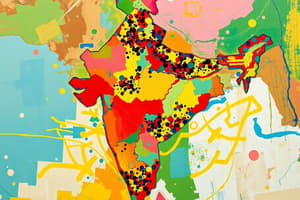Podcast
Questions and Answers
What is the current population of India as of 2023?
What is the current population of India as of 2023?
1.4 billion
What was the peak growth rate of India's population between 1970 and 1980?
What was the peak growth rate of India's population between 1970 and 1980?
2.1%
What percentage of India's population lives in urban areas?
What percentage of India's population lives in urban areas?
37%
Which state in India is the most populous?
Which state in India is the most populous?
What is the sex ratio at birth in India?
What is the sex ratio at birth in India?
What is the annual rate of urbanization in India?
What is the annual rate of urbanization in India?
What percentage of the Indian population belongs to the upper caste?
What percentage of the Indian population belongs to the upper caste?
What is the most widely practiced religion in India?
What is the most widely practiced religion in India?
How has internal migration influenced population distribution in India?
How has internal migration influenced population distribution in India?
What program, launched in 1952, has helped reduce India's high fertility rate?
What program, launched in 1952, has helped reduce India's high fertility rate?
What is crucial for India to focus on in order to effectively manage its population growth and distribution?
What is crucial for India to focus on in order to effectively manage its population growth and distribution?
What are some challenges of rapid urbanization in India?
What are some challenges of rapid urbanization in India?
Flashcards are hidden until you start studying
Study Notes
India's Demographic Landscape: A Look at Population Distribution
India, the world's second most populous country, is a kaleidoscope of cultures and demographics. Its population distribution, a reflection of the nation's rich heritage and evolution, sheds light on some notable patterns and diversity.
Size and Growth
As of 2023, India's population stands at approximately 1.4 billion. The country's population has grown exponentially since the mid-20th century, with a peak growth rate of 2.1% between 1970 and 1980. This rate has since slowed to 0.95% as of 2023.
Urban and Rural Divide
Around 37% of India's population lives in urban areas, with the remaining 63% residing in rural areas. This urban-rural divide is shifting, though, as the pace of urbanization has been accelerating at 3.4% annually.
Regions and States
India's population distribution varies by region, with the north, north-east, and west being more populous than the south and central regions. Each of India's 28 states and 8 union territories have their own distinct population structures. For instance, Uttar Pradesh, with a population of 241 million, is the most populous state, while the least populous state, Sikkim, has a population of around 650,000.
Demographic Groups
India's population is divided into several distinct groups:
- Age: Over 68% of India's population is under 35 years old.
- Gender: The sex ratio at birth is 846 females per 1,000 males.
- Religion: Hinduism is the most widely practiced religion (80.5%), followed by Islam (13.4%), Christianity (2.3%), and Sikhism (1.7%).
- Caste: India's caste system is a hierarchical social ranking, with the majority belonging to the lower castes. Only 3% of the population belong to the upper caste.
Factors Shaping Population Distribution
Several factors have contributed to India's current demographic structure, including:
- Geography: India's diverse topography, with its vast plains, mountain ranges, and coastal areas, allows for varied lifestyles and economic opportunities.
- Migration: Internal migration has been a significant factor in population distribution across India. Many people have migrated in search of better opportunities and employment, particularly from rural to urban areas.
- Population Policy: India's family planning program, launched in 1952, has been instrumental in reducing the country's high fertility rate.
Challenges and Opportunities
Population distribution in India presents both challenges and opportunities for the future. On one hand, rapid urbanization can lead to overcrowding and pollution in cities, while on the other hand, urbanization can provide opportunities for growth and economic development. To manage its population growth and distribution effectively, India must focus on balancing development and sustainability, ensuring that its resources are equitably distributed across the nation.
In conclusion, India's population distribution is a complex tapestry of various factors, including geography, migration, and religion. Understanding these patterns is crucial for the development of appropriate policies and strategies that address the challenges of the future while harnessing the opportunities that this diverse population presents.
Studying That Suits You
Use AI to generate personalized quizzes and flashcards to suit your learning preferences.




